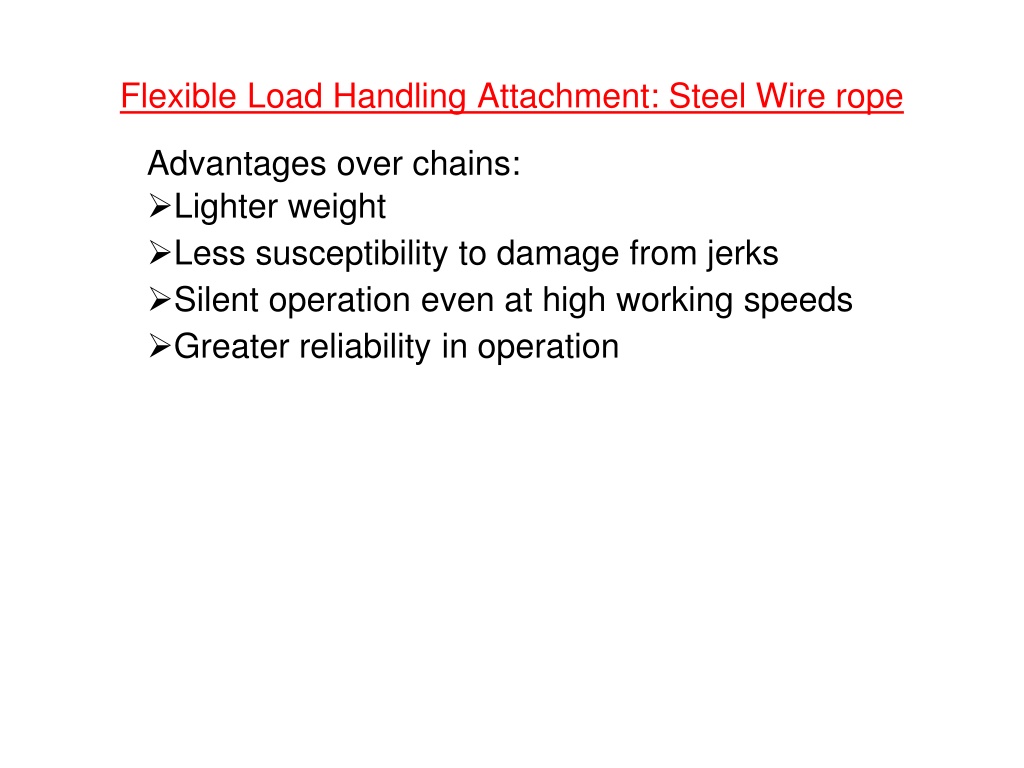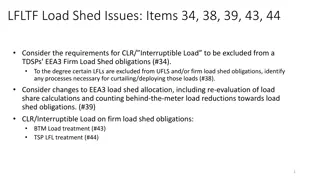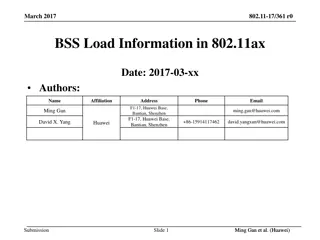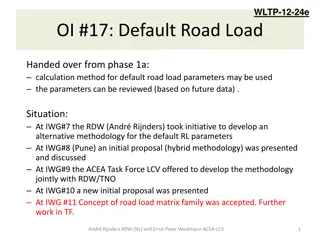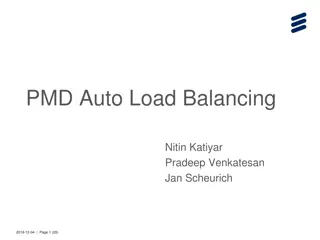Understanding Wire Ropes for Flexible Load Handling Attachment
Wire ropes offer advantages over chains for flexible load handling attachment, such as lighter weight, less damage susceptibility from jerks, silent operation, and greater reliability. They consist of multiple wires or strands wound about an axis, with independent components interacting during service. Different steel grades, finishes, and constructions are available to optimize strength, abrasion and crush resistance, bending fatigue resistance, and corrosion resistance for various applications. Cores, strand constructions, and lay types also impact wire rope characteristics like strength, flexibility, and robustness.
Download Presentation

Please find below an Image/Link to download the presentation.
The content on the website is provided AS IS for your information and personal use only. It may not be sold, licensed, or shared on other websites without obtaining consent from the author. Download presentation by click this link. If you encounter any issues during the download, it is possible that the publisher has removed the file from their server.
E N D
Presentation Transcript
Flexible Load Handling Attachment: Steel Wire rope Advantages over chains: Lighter weight Less susceptibility to damage from jerks Silent operation even at high working speeds Greater reliability in operation
Wire Ropes Wire rope consists of multiple wires or strands, helically wound or laid about an axis. Wires, strands and cores are independent- that interact with each other during service. Strand Wire ropes are designed in different steel grades, finishes and a variety of constructions to attain the best balance of strength, abrasion resistance, crush resistance, bending fatigue resistance and corrosion resistance for each application.
Wire ropes contd........ CORES Almost all wire ropes are laid up over a core, Fibre Core (natural or synthetic), Independent wire rope core or wire strand core (FC, IWRC or WSC): Core
STRAND CONSTRUCTIONS: Strands are designed with various combinations of wires and wire sizes to produce the desired resistance to fatigue and abrasion. Generally, a small number of large wires will have more abrasion resistant and less fatigue resistant than a large number of small wires. The basic strand has wires of the same size wound around a centre. Provides excellent abrasion resistance but less fatigue resistance. When used with an IWRC, it also offers excellent crush resistance over drums. Small wires fill spaces between large wires to produce crush resistance and a good balance of strength, flexibility and resistance to abrasion Outer layer of alternately large and small wires provides good flexibility and strength but low abrasion and crush resistance.
Wire ropes contd........ Many commonly used wire ropes use combinations of these basic constructions
Wire ropes contd........ Lays of wire ropes Regular lay or Cross lay Lang lay or Parallel lay Alternate lay or Reverse lay Lang lay is recommended for excavating, construction, and mining applications including draglines, hoist lines. This is because of the Lang lay ropes are more flexible than regular lay ropes. They also have greater wearing surface per wire than regular lay ropes
Wire ropes contd........ Characteristics of a wire ropes: (1) Strength (2) Flexibility (3) Robustness Strength can be increased by: increasing the diameter of the wire rope increasing the tensile strength of the individual wires decreasing the air voids between the wires using a steel core construction. Flexibility can be increased by: using more wires of a smaller diameter decreasing the tensile strength of the individual wires using a fiber core. Robustness, or resistance to physical damage: increased by using fewer wires of a larger diameter using a steel core Coatings can be applied to protect against corrosion.
Wire ropes contd........ Selection of wire rope for a particular application: a) Strength b) Abrasion resistance c) Flexibility d) Resistance to crushing e) Fatigue strength and corrosion resistance
Locked-coil steel wire ropes Applications: Cable ways, Cable cranes etc. Advantages: Smooth surface, Tightly packed wires and less flexible Semi Locked-coil Locked-coil
Wire ropes contd........ Wire Rope Size Measurement Designation of a wire rope: 20 mm 6*19 (12/6/1) wire Nominal diameter of wire rope : 20 mm No. of strands: 6 No. of wires in each strand :19. (may be formed by 12 wires over 6 wires with 01 core wire)
6x7 Class Wire Rope 6x19 Class Wire Rope Strands: 6 Wires per strand: 19 Core: IWRC or fiber core Lay: Regular or Lang Finish: Bright or galvanized Strands: 6 Wires per strand: 7 Core: Fiber core Lay: Regular or Lang Finish: Bright or galvanized 6x19 Seale with IWRC Stiff rope needs sheaves and drums of large size. 6x19 Warrington with fiber core
Fleet angle in wire rope: Range of Fleet angle for maximum efficiency and service: < 1.5o for smooth drum < 2o for grooved drum Large fleet angle: results in excessive rubbing of the rope against the flanges of the drum and the sheave groove, or crushing and abrasion of the rope on the drum.
Factors Affecting Rope Performance: Multi-coiling Bad coiling Small diameter sheaves Oversize grooves Undersize grooves Excessive angle of fleet
Factors Influencing the lifetime of wire ropes: type of wire ropes; diameter of the drums and sheaves; reverse bending speeds with which the wire ropes run through the sheaves ratio between normal working load and the maximum load in the wire ropes; safety factor; being the ratio between the breaking load and the normal working load choice of the hardness in the groove of the sheaves; fleet-angle between the wire rope and the sheave, respectively between the drum groove and wire rope; greasing or lubrication of the wire ropes and the frequency of greasing or lubrication; mechanical damage
Selection of drum and sheave diameter For faster operation of ropes in cranes: D/d=30 For fast un-loaders: D/d= 36 Where, D= sheave diameter or drum diameter, centre to centre of wire rope, d= wire rope diameter.
Dimension of grooves on drums and in sheaves: Drum Sheave
